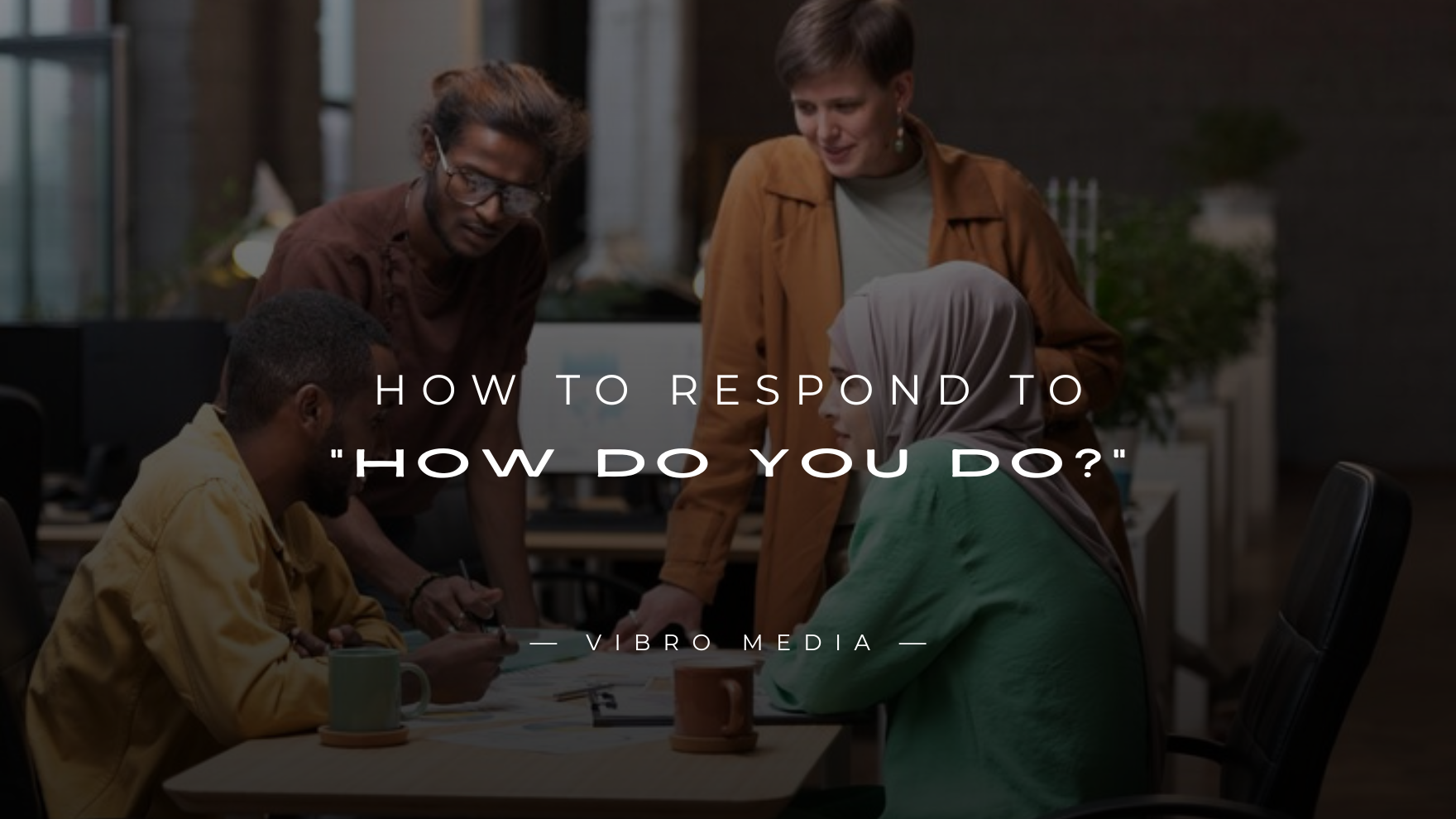Have you ever found yourself in a situation where someone greets you with “How do you do?” and you’re unsure of how to respond? Don’t worry – you’re not alone! This seemingly simple phrase can often confuse, especially for those unfamiliar with its use. In this article, we will break down the meaning of “How do you do?” and explore the best ways to respond to it, depending on the context and situation.

What Does “How Do You Do?” Mean?
“How do you do?” is a traditional, formal greeting that originated in British English. It is used as a polite, introductory question when meeting someone for the first time. Contrary to what some might believe, it isn’t really a question about your well-being or health, like “How are you?” Instead, it’s more of a social convention or formality to acknowledge the other person’s presence.
The phrase may sound odd to modern ears because it doesn’t require an actual answer about how you’re feeling. In fact, the response is often just a polite repetition of the phrase itself.
“How Do You Do?” vs. “How Are You?”
While “How do you do?” and “How are you?” might seem interchangeable, there are key differences between them. “How are you?” is a more casual, informal greeting, and it does expect a genuine answer about your health or mood. For example, you might reply, “I’m doing well, thanks!” or “I’m feeling great today!”
On the other hand, “How do you do?” is reserved for more formal or professional settings, especially when meeting someone new for the first time. It’s not typically followed by an emotional or health-related response, but rather a polite acknowledgment.
The Right Way to Respond to “How Do You Do?”
When someone greets you with “How do you do?” it’s important to respond with a similar level of formality. The most common response is simply to repeat the phrase back: “How do you do?” This maintains the polite, formal tone of the greeting and avoids any awkwardness.
For instance, if you’re at a business meeting or a formal event, replying with “How do you do?” shows respect and politeness. The exchange is often followed by a handshake or another form of greeting, such as a nod.
Formal Responses to “How Do You Do?”
If you’re in a formal setting, such as a business event, an interview, or a diplomatic meeting, the best response to “How do you do?” is simply to repeat the phrase. You can say:
- “How do you do?”
- “It’s a pleasure to meet you, how do you do?”
- “How do you do? I’m pleased to make your acquaintance.”
These responses convey respect and adhere to traditional etiquette. They are especially important in cultures that emphasize politeness and formality in initial interactions.
Informal Responses to “How Do You Do?”
In informal settings, however, the tone of the exchange can shift. You might respond with a slightly more casual approach, depending on the nature of your relationship with the person. For example:
- “Hi! How do you do?”
- “Nice to meet you, how do you do?”
These responses are still respectful but convey a slightly more relaxed tone than the formal repetition of the phrase.
Why “How Do You Do?” Can Be Confusing
The main reason people struggle with responding to “How do you do?” is because it’s not really a question about one’s well-being or condition. It can sound like it requires an answer, but it’s more about the social ritual of greeting someone. In many cases, people might mistakenly respond with something like “I’m good, thanks!”—which would be appropriate for “How are you?” but not for “How do you do?”
Regional Variations in Response
Cultural differences can also play a role in how you respond to “How do you do?”. For instance, in some parts of the UK, this greeting is still commonly used in more formal settings, while in the United States, it has largely fallen out of everyday conversation. You may find that in some American cities, people will automatically revert to “How are you?” even in formal circumstances.
Similarly, in other English-speaking countries like Australia or Canada, the formality of the response can vary, but “How do you do?” is still understood to be a polite and formal greeting.
Responding to “How Do You Do?” in Business Settings
In a professional or business context, responding correctly to “How do you do?” is essential for making a positive first impression. Whether you’re attending a meeting, a conference, or a job interview, keeping your response formal is key. Avoid casual responses like “I’m good” or “Hey, how are you?” as they might be considered unprofessional or too informal.
A simple, “How do you do?” or “It’s a pleasure to meet you, how do you do?” shows confidence, politeness, and a sense of professionalism.
Using “How Do You Do?” in Job Interviews
When you’re in a job interview, the stakes are high, and first impressions matter. If the interviewer greets you with “How do you do?” it’s important to match their tone and return the greeting in kind. A good response might be:
- “How do you do? I’m very excited to be here.”
- “It’s a pleasure to meet you, how do you do?”
These responses are formal, respectful, and reflect well on your interpersonal skills.
How “How Do You Do?” Reflects Social Etiquette
In many societies, the way we greet each other says a lot about our social awareness and etiquette. “How do you do?” reflects an understanding of the importance of politeness and respect, especially in professional and formal contexts. It signifies a willingness to acknowledge someone’s presence without delving too deeply into personal matters.
In many cultures, being able to respond appropriately to “How do you do?” can help you navigate social situations with grace and confidence.
What to Avoid When Responding to “How Do You Do?”
When answering “How do you do?”, there are a few things you should avoid. First, don’t mistake the greeting for a casual inquiry about your well-being. Responding with “I’m good” or “I’m doing well” may cause confusion, as it’s not the expected response.
Additionally, avoid using overly familiar or overly casual language, especially in professional settings. This could come off as unprofessional or disrespectful, even if that’s not your intention.
Avoiding Overfamiliarity
It’s important to keep the response neutral and polite, without being overly familiar. For instance, using phrases like “Hey, what’s up?” or “Yo, how’s it going?” would not be appropriate when responding to “How do you do?” These kinds of responses would likely seem out of place and could potentially harm your professional image.
Conclusion
In conclusion, responding to “How do you do?” may seem simple, but it offers an opportunity to make a positive impression in both professional and social settings. With over 150 replies at your disposal, you can choose the perfect response based on the situation, whether it’s formal, casual, or even humorous. By mastering this greeting, you’ll be able to engage in conversations with confidence. If you’re interested in expanding your conversational skills even further, check out our guide on how to respond when someone says “Yeah Sure” with over 150 creative replies here.
FAQs
Q. What is the meaning of “How Do You Do?”
“How do you do?” is a formal greeting used when meeting someone for the first time. It’s a way to acknowledge the other person’s presence without asking about their well-being.
Q. How do I respond if I’m unsure?
If you’re unsure how to respond, simply repeat the phrase: “How do you do?” It’s the most common and safest response.
Q. Is “How Do You Do?” used in American English?
While it’s more commonly used in British English, “How do you do?” is still understood in American English, though it’s more formal and less frequently used.
Q. Can I use “How Do You Do?” in a casual setting?
No, “How do you do?” is generally reserved for formal settings. In casual settings, it’s better to use “How are you?” or other informal greetings.
Q. Is “How Do You Do?” still common today?
While it may not be as common in everyday conversation, “How do you do?” is still used in formal and professional contexts, such as business meetings and interviews.










